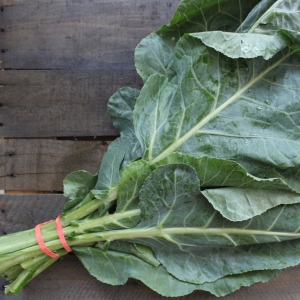Move over kale, collards are in! Collard greens, a staple in the southern United States, have become increasingly popular throughout the rest of the country. A dark green member of the cruciferous family of veggies, collards are a bitter green that pack a nutritional punch not unlike their close cousin, kale.
While kale is quite bitter and tough, collard greens tend to be more tender and slightly sweeter in flavor. Bitter greens like collards are packed with vitamins and rich in minerals. Collards, in particular, are a great source of calcium, containing nearly the same amount as milk, and a good source of both vitamin C and soluble fiber.
The incredible health benefits of Collard Greens include:
- One of the best plant-based sources of calcium
- High in vitamin A, K, and beta-carotene, promoting great skin & heart health
- High in vitamin C, our immunity booster
- High in vitamin B5, which is essential for coping with stress
- Naturally iron-rich
- Contain more protein than most bitter green veggies
- Collards are bitter, which activates the taste buds, releases enzymes, and increases bile flow, making them a DIGESTIVE POWERHOUSE
- One of the best sources of sulfur compounds that neutralize toxic substances, making them excellent for natural DETOXIFICATION
Because of their supportive role in digestion and detox, collard greens are included in the protocol for this season’s signature detox. Find out more here!
Buying and Storing Collards:
Collards are a warming food, perfect during the colder winter months. While collard greens are available throughout the year, their peak flavor is in late fall and winter, when frost aids in producing sweeter tasting crops. During warmer weather, collards can still be harvested, but their texture is less tender.
When shopping for collards, look for firm, fresh leaves that are smaller in size. The smaller the leaf, the milder the flavor. Stored in the refrigerator in a plastic bag, they will remain fresh for up to 5 days. Make sure to wash your collards prior to use, not before storing.
Quick Serving Ideas:
- Simply steam for 5 minutes, or until tender; season with a sprinkle of sea salt and a drizzle of extra virgin olive oil
- Replace kale in your winter smoothies
- Add to winter soups, stews, or stir-fries
- Use as a wrap for shredded carrot, sliced avocado, sliced red pepper, chopped red onion, sliced cucumber, sprouts, and your favorite pate.
- In the south, they are commonly cooked with ham or pork. For a healthy upgrade try this recipe for Collard Greens With Turkey Bacon
If you’re unfamiliar with this dark green member of the cruciferous family of veggies, I highly recommend you try them. And if you’re regularly eating kale, collard greens are an easy next step.
Your Simple Action Plan:
Add collard greens to your winter grocery list!
For more collard recipes, and a protocol to support your digestion and detox, join me for Nourish, this season’s signature detox program. Find out more here!




